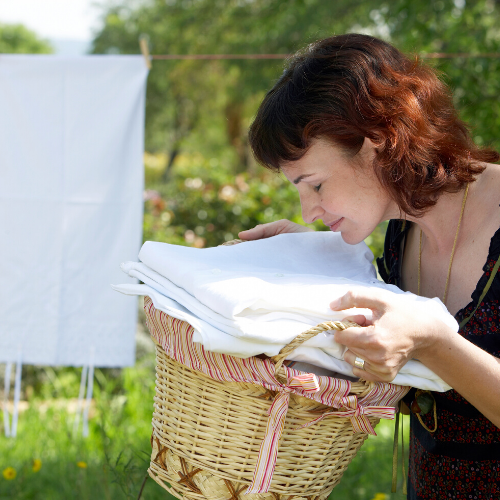Linen isn’t just any piece of cloth. This fabric has been used for thousands of years and has remained a staple in the textile industry because of its strength, durability and breathability.
Made from fibers that are sourced from the stems of flax plants, linen is three times stronger than cotton, making it a great choice for fine linens, bedding, clothing and home textiles.
Perfected over the course of hundreds of generations, the process of transforming a flax plant is lengthy. However, this process produces a luxurious textile that is well worth the wait, making it a top choice for manufacturers and designers across several industries.
Here are 4 reasons why people love flax linen, and why you will, too.
1. Linen Is Moisture-Resistant, Hypoallergenic And Breathable
 Linen comes from the cellulose-based fibers of the flax plant that are hypoallergenic, moisture-resistant and breathable. In fact, linen can absorb dampness up to 20% without even feeling wet. It’s often hidden dampness that leads to bacterial growth, so this feature keeps bedding healthier over time.
Linen comes from the cellulose-based fibers of the flax plant that are hypoallergenic, moisture-resistant and breathable. In fact, linen can absorb dampness up to 20% without even feeling wet. It’s often hidden dampness that leads to bacterial growth, so this feature keeps bedding healthier over time.
Flax is naturally hypoallergenic and is considered to be a natural fiber that is friendly to a person’s skin. Because linen is hypoallergenic, it is perfect for allergy sufferers.
For those who live in hot climates, linen is a great choice to keep you cool in the summer. Yet, it also has the ability to keep you warm in the winter, making this a great year-round textile for clothing and bedding.
Breathability is especially important in bedding because it allows for better regulation of your body temperature. This, in turn, impacts how well you sleep at night. In fact, Harvard University notes that your sleep environment can have a significant impact on your sleep and overall health, confirming the importance of a good night’s rest.
And, there’s even better news. Linen actually gets softer and improves as it ages … even after cleaning it multiple times. This ensures that clothing, bedding and furniture stay fresher longer.
2. Linen Is Extremely Sustainable
Linen is known for being one of the most sustainable textiles available.
Flax is typically planted in a cool climate and harvested 100 days later. Fibers from the plant are separated, and the leaves and seeds of the plant are removed. Flax fibers located inside the dried stems are also removed.
When growing flax, very little water is required so farmers do not need to irrigate or fertilize during this process. Flax typically requires little to no pesticides, herbicides and fungicides as well.
As mentioned above, very little is wasted with flax. Other parts of the plant, such as its seeds, can be used to produce oil or flax seeds for consumption.
And, because linen is extremely durable, it has a longer lifespan. When discarded, linen is biodegradable.
3. Linen Doesn’t Require Extra Care
 One of the best features customers love is that linen does not require extra care. Washing and caring for linens is pretty straightforward, making this fabric an attractive choice and selling point.
One of the best features customers love is that linen does not require extra care. Washing and caring for linens is pretty straightforward, making this fabric an attractive choice and selling point.
Linen can be cleaned and dried in an individual’s washing machine and dryer, though it can also be hand-washed or dry-cleaned using professional services.
Our article, How To Wash Linen, explains the various washing and drying methods you should use when caring for linens, but in general, there are a few things to keep in mind.
- Hot water may cause linen fabric to shrink or may weaken the fibers.
- Never twist linen fabric or scrub it, since this can damage the fibers.
- Bleaching is not recommended for linens since it can discolor the fabric and weaken the linen fibers.
- Dry on low heat and remove linens while they are somewhat damp, or iron on a low to medium-hot setting while the fabric is still somewhat damp.
There is one final note to keep in mind. For linens located in high-trafficked areas, regular maintenance is important to retain the fabric’s fresh feel.
4. It Can Be Used For Many Products
Because of the benefits mentioned above, linen is highly sought after for use in many products.
Companies that manufacture clothing, bedding, window treatments, furniture and home goods regularly use linen for their products because of the fabric’s durability, high quality and moisture-resistant features.
However, linen is also used in many other products in the market, including:
- Rugs
- Rope
- Curtains
- Bandages
- Dolls
- Luggage
- Books
One more fun fact...Linen is even combined with cotton to make paper currency.
So, as you can see, linen is a special textile. Considering it’s been used for thousands of years, it’s no surprise how popular linen has remained across many generations.
To learn more about the fascinating process behind flax linen production, check out our article, What Is Linen Made From?





